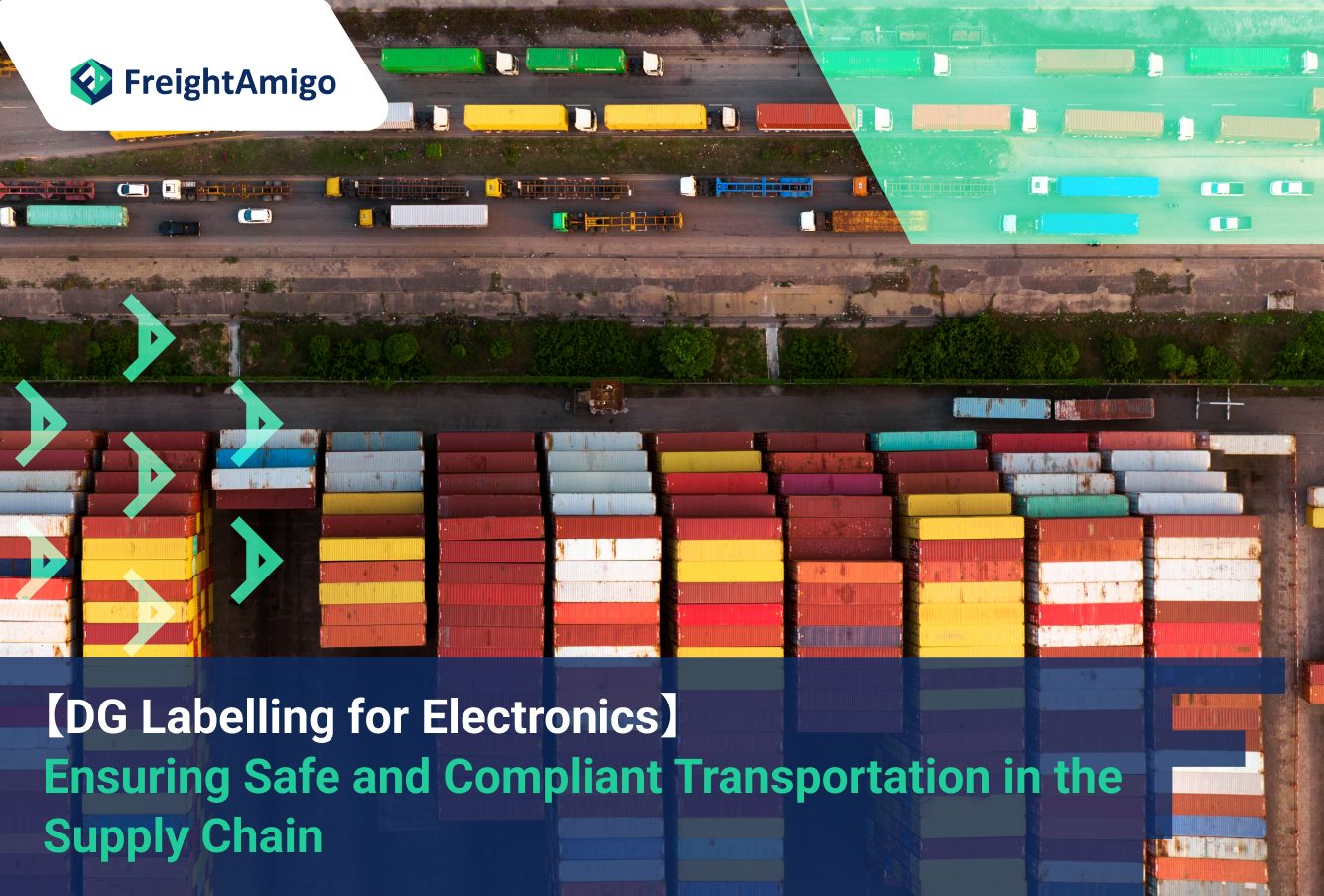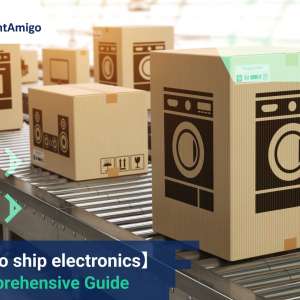January 18th, 2024: Maya Wong– Marketing Analyst at FreightAmigo
The role of DG (Dangerous Goods) labelling in supply chain management is crucial, especially when it comes to the transportation of electronics. From packaging and storage to logistics and delivery, proper labelling plays a vital role in ensuring the safe and compliant movement of electronic goods throughout the supply chain. In this comprehensive guide, we will explore the importance of DG labelling for electronics and how it contributes to the efficiency, security, and transparency of the supply chain.
Want to compare the best Express, Air Freight, Sea Freight, Rail Freight & Trucking rates so as to have better control on cost?
Importance of DG Labelling in the Electronics Industry
In the fast-paced world of electronics, where technological advancements are constant, the need for efficient and reliable supply chain management is paramount. This includes proper labelling of electronic goods to comply with regulatory requirements and ensure the safety of both the products and the individuals handling them.
Ensuring Compliance and Safety
DG labelling ensures compliance with regulations that govern the transportation of hazardous materials, including electronics. It provides crucial information about the nature of the goods, potential risks, and necessary precautions. By clearly labelling electronic products as dangerous goods, it helps prevent accidents, spills, and exposure to potential hazards.
Facilitating Efficient Logistics Operations
Efficient logistics operations are essential for the smooth flow of electronic goods through the supply chain. DG labelling enables easy identification and tracking of electronic products, reducing the chances of mix-ups, delays, or improper handling. With proper labelling, logistics personnel can quickly locate and handle electronic goods, ensuring timely delivery and minimizing disruptions.
Enhancing Transparency and Traceability
Transparency and traceability are key factors in supply chain management. DG labelling provides a clear trail of information about the origins, destinations, and handling of electronic goods. By incorporating barcodes or RFID technology, labels enable real-time monitoring and tracking of products, enhancing visibility and facilitating better decision-making.
Empowering Consumers with Information
In today’s consumer-driven market, consumers are increasingly conscious of the products they purchase, particularly when it comes to electronics. DG labelling empowers consumers by providing essential information about the electronic goods they are considering. This includes details about potential hazards, safe usage instructions, and environmental impact. Labels also enable consumers to make informed choices based on their preferences, such as ethical considerations or sustainability.
Types of DG Labels for Electronics
DG labelling for electronics encompasses various types of labels, each serving different purposes. These labels are designed to provide comprehensive and accurate information about the electronic goods, facilitating safe handling and transportation. Let’s explore the common types of DG labels used in the electronics industry.
Barcode Labels
Barcode labels are widely used to label electronic goods in warehouses and throughout the supply chain. These labels consist of a barcode that can be easily scanned using barcode readers or scanners. The barcode contains encoded information about the product, such as its unique identification number, specifications, and safety considerations. Barcode labels enable quick and accurate identification of electronic products, streamlining logistics operations and reducing errors.
RFID Tags
RFID (Radio Frequency Identification) tags are another type of DG label used in the electronics industry. These tags use radio frequency technology to transmit and receive data wirelessly. RFID tags are embedded with a microchip that stores essential information about the electronic goods. When scanned using an RFID reader, the tag provides real-time data about the product, including its location, condition, and other relevant details. RFID tags enhance traceability, improve inventory management, and enable seamless tracking of electronic goods throughout the supply chain.
E-ink Labels
E-ink labels, also known as electronic ink labels, offer a modern and dynamic approach to DG labelling for electronics. These labels incorporate e-ink technology, which allows the display to change and update as needed. E-ink labels provide real-time information about electronic goods, including product specifications, safety instructions, and other relevant details. With e-ink labels, updates can be made easily, reducing the need for manual relabelling and ensuring accurate and up-to-date information is readily available.
Best Practices for DG Labelling in the Electronics Industry
To ensure the effectiveness of DG labelling in the electronics industry, it is essential to follow best practices and comply with regulatory standards. Here are some key considerations for implementing DG labelling in the electronics supply chain:
Compliance with Regulations
Compliance with regulations is of utmost importance when it comes to DG labelling for electronics. It is crucial to stay updated with the latest regulatory requirements, such as those outlined by organizations like IATA (International Air Transport Association) and ICAO (International Civil Aviation Organization). Adhering to these regulations ensures the safe and legal transportation of electronic goods and minimizes the risk of non-compliance penalties or disruptions in the supply chain.
Clear and Conspicuous Labelling
DG labels for electronics should be clear, legible, and prominently displayed on the packaging or product. Labels should use appropriate fonts, colors, and sizes to ensure easy visibility and readability. The information on the label, including hazard symbols, product identification, and safety instructions, should be clearly communicated to facilitate proper handling and minimize the risk of accidents or mishandling.
Standardization and Consistency
Standardization and consistency in DG labelling are essential for effective communication across the supply chain. Implementing standardized label formats, symbols, and codes ensures that all stakeholders can easily understand and interpret the information on the labels. Consistency in labelling practices throughout the supply chain streamlines operations, reduces errors, and enables seamless collaboration among different entities.
Integration with Technology
Leveraging technology is key to optimizing DG labelling processes in the electronics industry. Incorporating barcode scanning systems, RFID tracking systems, or e-ink label technologies can enhance the efficiency, accuracy, and automation of labelling operations. Integration with warehouse management systems or supply chain management software allows for real-time data exchange, further improving traceability and transparency.
Training and Communication
Proper training and communication are vital to ensure that all personnel involved in the supply chain understand the importance of DG labelling and adhere to the established labelling protocols. Training programs should cover topics such as label application techniques, safety procedures, and regulatory compliance. Effective communication channels should be established to address any labelling-related concerns or updates, fostering a culture of safety and compliance throughout the supply chain.
Conclusion
DG labelling plays a critical role in ensuring the safe and compliant transportation of electronics throughout the supply chain. By providing essential information, facilitating efficient logistics operations, enhancing transparency, and empowering consumers, DG labels contribute to the overall success and integrity of the electronics industry. Implementing best practices, including compliance with regulations, clear labelling, standardization, integration with technology, and comprehensive training, is essential for optimizing DG labelling processes and ensuring the smooth flow of electronic goods from origin to destination. As the electronics industry continues to evolve, embracing innovative labelling solutions will be crucial to meet the demands of a rapidly changing market and ensure the sustainable growth of the sector.
There are different options for cargo transportation. If you want to choose the most convenient and suitable solution, it is best to have the full support of logistics experts! If you are planning to ship goods overseas, please go to the FreightAmigo page for inquiries.
===
Read More:
【A Comprehensive Guide】 How to Safely Ship a Computer
【Level Up Your Shipping Game】 How to Safely Ship Your Previous Gaming PC
【Understanding the Essentials】 Labeling Requirements for Shipping Toys
===
If you have any inquiries on logistics/supply chain, feel free to contact FreightAmigo now:
Chat with us online OR Hotline: +852 28121686 OR WhatsApp: +852 27467829









































